Colorado School of Mines
The Colorado School of Mines (informally Mines) is a public research university in Golden, Colorado, founded in 1874. The school offers both undergraduate and graduate degrees in engineering, science, and mathematics, with a focus on energy and the environment. While Mines does offer minor degrees in the humanities, arts, and social sciences, it only offers major degrees in STEM fields. In the Fall 2019 semester, the school had 6,607 students enrolled, with 5,155 in an undergraduate program and 1,452 in a graduate program.[2] The school has been co-educational since its founding, however, enrollment remains predominantly male (69.2% as of Fall 2020).[2] In every QS World University Ranking from 2016 to 2020, the university was ranked as the top institution in the world for mineral and mining engineering.[6] It is classified among "R2: Doctoral Universities – High research activity".[7]
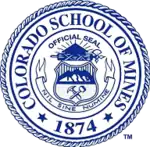 | |
| Motto | Nil sine numine (Latin) |
|---|---|
Motto in English | Nothing without God's will |
| Type | Public research university |
| Established | 1874 |
Academic affiliations | Space-grant |
| Endowment | $289.0 million (2019)[1] |
| President | Paul C. Johnson |
| Students | 6,607 (Fall 2019)[2] |
| Undergraduates | 5,155 (Fall 2019)[2] |
| Postgraduates | 1,452 (Fall 2019)[2] |
| Location | , , United States 39°45′4″N 105°13′21″W |
| Campus | Suburban, 373 acres (1.51 km2)[3] |
| Colors | Blue & Silver[4] |
| Nickname | Orediggers |
Sporting affiliations | NCAA Division II – Rocky Mountain |
| Mascot | Marvin the Miner Blaster the Burro[5] |
| Website | www |
History
Early history
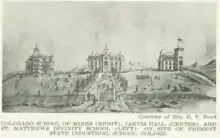
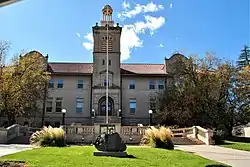
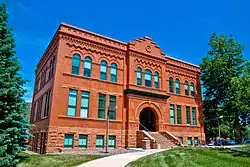
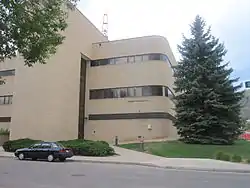
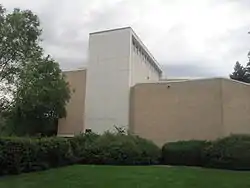
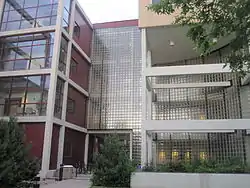
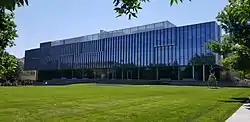
Golden, Colorado, established in 1859 as Golden City, served as a supply center for miners and settlers in the area. In 1866, Bishop George M. Randall of Massachusetts arrived in the territory and, seeing a need for higher education facilities in the area, began planning for a university which would include a school of mines. In 1870, he opened the Jarvis Hall Collegiate School in the central building of the Colorado University Schools campus just south of the town of Golden, accompanied it with Matthews Hall divinity school in 1872, and in 1873 the School of Mines opened under the auspices of the Episcopal Church. In 1874 the School of Mines, supported by the territorial government since efforts began in 1870, was acquired by the territory and has been a state institution since 1876 when Colorado attained statehood. Tuition was originally free to residents of Colorado.[9] The school's logo was designed by prominent architect Jacques Benedict.
The first building on the current site of the school was built in 1880 with additions completed in 1882 and 1890. The building, known as "Chemistry Hall," stood where Hill Hall is now located. The next building to be added to the campus was Engineering Hall, built in 1894, which is still in use today by the Economics and Business Division.
Other firsts include the first Board of Trustees meeting held in 1879; the first formal commencement held in 1883 for two graduates (William Beebe Middleton and Walter Howard Wiley); the first international student graduated in 1889; and the first female student graduated in 1898. In 1906, Mines became the first school of its kind in the world to own and operate its own experimental mine, designed for practical teaching of the students, which was located on Mt. Zion and succeeded in the 1930s by the Edgar Mine. In 1879, there was some discussion about merging School of Mines and the State University in Boulder. Apparently, because of the specialized focus of School of Mines, it was decided that such a merger would not be appropriate. During the early years of the institution, the chief administrator was the "Professor in Charge". The designation "President" was first used in 1880. The "M" on Mt. Zion, a prominent feature in the Golden area, was constructed in 1908 and lighted in 1932.
Early academic departments were drafting, physics, metallurgy, chemistry and mining. In the 1920s, departments formed in geology, petroleum engineering and geophysics. Petroleum refining was added in 1946. The Humanities, Arts and Social Sciences Division (formerly Liberal Arts and International Studies) and the Department of Physical Education and Athletics provide nontechnical educational opportunities for Mines students. Other facilities include: Ben Parker Student Center, Arthur Lakes Library, Green Center and the Edgar Mine which is located in Idaho Springs.
Recent history
The Colorado School of Mines is a public research university devoted to engineering and applied science.
In August 2007, a new student recreation center was completed. In 2008, the school finished expanding its main computer center, the Center for Technology and Learning Media (CTLM). In May 2008 the school completed construction and installation of a new supercomputer nicknamed "Ra"[10] in the CTLM managed by the Golden Energy Computing Organization (GECO), a partnership among the Colorado School of Mines, the National Renewable Energy Laboratory, the National Center for Atmospheric Research and the National Science Foundation. In 2014, CoorsTek granted a $27 million investment to the university, leading to the 2017 opening of the CoorsTek Center for Applied Science and Engineering, a multi-disciplinary building on campus dedicated to both academic and research activities.[11]
Mines is the host of the annual Colorado State Science Olympiad, which draws teams from both the northern regional (hosted at Poudre High School) and southern regional (hosted at the University of Colorado at Colorado Springs) competitions. One or two teams usually advance to the national finals, depending on the number of teams registered to compete. Mines also hosts the Colorado Regional Science Bowl, and shares hosting of the Colorado State MathCounts Competition with University of Denver, alternating biennially.
Since 1964, the Colorado School of Mines has hosted the annual oil shale symposium, one of the most important international oil shale conferences. Although the series of symposia stopped after 1992, the tradition was restored in 2006.[12]
Presidents
- Chris Stell. – 1873[n 1]
- Gregory Board – 1875[n 1]
- Milton Moss – 1878[n 1]
- Albert C. Hale – 1880[n 2]
- Regis Chauvenet – 1883
- Charles S. Palmer – 1902
- Victor C. Alderson – 1903[n 3]
- William G. Haldane – 1913
- William B. Phillips – 1915
- Howard C. Parmelee – 1916
- Victor C. Alderson – 1917[n 3]
- Melville F. Coolbaugh – 1925
- Ben H. Parker – 1946
- John W Vanderwilt – 1950
- Orlo E. Childs – 1963
- Guy T. McBride, Jr. – 1970
- George S. Ansell – 1984
- Theodore A. Bickart – 1998
- John U. Trefny – 2000
- Myles W. Scoggins – 2006
- Paul C. Johnson – 2015
Campus

Colorado School of Mines is located to the southwest of Golden's downtown, bordered to the west by U.S. Route 6 and to the north by Clear Creek. The campus spans 373 acres (1.51 km2),[3] including over a dozen academic and research buildings, indoor and outdoor athletic facilities, two student centers, a library, eight residential halls, and administration buildings. Additionally, the campus hosts a research building for the United States Geological Survey,[13] housing the National Earthquake Information Center.
The school operates the free admission Mines Museum of Earth Science, which displays rock and mineral specimens collected from Colorado's numerous mining districts as well as around the world. Notable objects in the collection include one of the "Goodwill" Apollo 17 lunar samples and the Miss Colorado crown. [14][15]
The design of the university's buildings have varied widely over time, spanning a spectrum of styles from Second Empire to Postmodernist, created by noted Colorado architectural masters including Robert S. Roeschlaub (Hall of Engineering), Jacques Benedict (Steinhauer Field House), and Temple Hoyne Buell (Berthoud Hall). To date, three main academic buildings are gone (original Territorial School of Mines, 1871–93; Hall of Chemistry, 1880–1958; Paul Meyer Hall, 1963–2016), while the present campus includes:
- Alderson Hall
- Chemical and Biological Engineering
- Berthoud Hall
- Geology and Geological Engineering
- Brown Hall (Building)
- Engineering (Civil, Electrical, Mechanical, undergraduate Environmental)
- Computer Science
- Mining Engineering
- Chauvenet Hall
- Applied Math and Statistics
- Coolbaugh Hall
- Chemistry and Geochemistry
- CoorsTek Center for Applied Science and Engineering
- Physics
- Center for Technology and Learning Media (CTLM)
- Academic Computing and Networking
- Engineering Hall
- Economics and Business
- General Research Laboratory and Museum of Earth Science
- Green Center
- Geophysics
- GC Office of Events
- Guggenheim Hall
- President's Office
- Administrative Offices
- Hill Hall
- Materials Science
- Metallurgical and Materials Engineering
- Arthur Lakes Library
- Library
- Marquez Hall
- Petroleum Engineering
- Moly Building
- Colorado Geological Survey
- Recreation Center
- Starzer Welcome Center
- Admissions
- Colorado School of Mines Alumni Association
- Colorado School of Mines Foundation
- Stratton Hall
- Humanities, Arts and Social Sciences
- Applied Math and Statistics (not primary location)
- Steinhauer Field House
- Student Center
- Financial Aid
- Bookstore
- Registrar
- Student Life
- Student Health Center
- U.S Geological Survey
- National Earthquake Information Center
- National Landslide Information Center
- Volk Gymnasium
- Physical Education and Athletics
Major open-air athletic facilities of the Colorado School of Mines include historic Campbell Field and Darden Field.
The honorary named Colorado School of Mines buildings commemorate Dr. Victor C. Alderson, Edward L. Berthoud, George R. Brown, Dr. Regis Chauvenet, Dr. Melville F. Coolbaugh, Cecil H. and Ida Green, Simon Guggenheim, Nathaniel P. Hill, Arthur Lakes, Dr. Paul D. Meyer, Winfield S. Stratton, and Russell K. Volk.
Academics
Mines is organized around 16 academic departments and 14 interdisciplinary programs:
- Advanced Manufacturing
- Advanced Energy Systems
- Applied Mathematics and Statistics
- Chemical and Biological Engineering
- Chemistry
- Civil and Environmental Engineering
- Computer Science
- Economics and Business
- Electrical Engineering
- Energy
- Engineering, Design and Society
- Geochemistry
- Geology and Geological Engineering
- Geophysics
- GIS and Geoinformatics
- Humanities, Arts and Social Sciences
- Mechanical Engineering
- Metallurgical and Materials Engineering
- Military Science/ROTC
- Mining Engineering
- Nuclear Science and Engineering
- Operations Research with Engineering
- Petroleum Engineering
- Physics
- Quantitative Biosciences and Engineering
- Space Resources
- Underground Construction and Tunneling
Mines began the world's first graduate program in space resources in the fall semester of 2018, offering both master's and PhD degrees.[16]
Rankings
| University rankings | |
|---|---|
| National | |
| ARWU[17] | 155–175 |
| Forbes[18] | 94 |
| THE/WSJ[19] | 169 |
| U.S. News & World Report[20] | 88 |
| Washington Monthly[21] | 78 |
| Global | |
| ARWU[22] | 601–700 |
| THE[23] | 401–500 |
| U.S. News & World Report[24] | 503 |
|
USNWR departmental rankings[25] | |
|---|---|
| Chemistry | 96 |
| Computer Science | 91 |
| Earth Sciences | 28 |
| Engineering | 59 |
| Mathematics | 117 |
| Physics | 71 |
- Tied for 34th in U.S. News & World Report's 2021 "Top Public Schools" in the U.S.[25]
- 42nd in U.S. News & World Report's 2021 "Best Engineering Graduate Schools" in the U.S.,[25] with the Petroleum Engineering program ranked 4th.[26]
- Tied for 88th in U.S. News & World Report's 2021 "Best National Universities Rankings".[25]
- 83rd out of 174 schools ranked in Kiplinger's Personal Finance magazine's 2019 "Best Values in Public Colleges."[27]
- 9th in "USA Today's Top 10 Engineering Schools 2015".[28]
Admissions
For freshmen entering Fall 2019, Colorado School of Mines received 11,756 applications, accepted 6,240 (53.1%) and enrolled 1,282 (20.5% of those accepted).[29] The middle 50% range of SAT scores for the enrolled freshmen was 620–710 for evidence-based reading, and 640–750 for math, while the ACT Composite range was 27–33.[29] The average GPA was 3.78. Men constituted 66.1% of the incoming class, women 33.9%.[29]
Traditions
E-Days
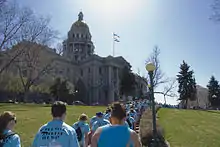
Each spring semester, the Colorado School of Mines students and faculty celebrate E-days (or Engineering Days). This three-day festival is kicked off Friday morning with the "Ore Cart Pull". This event consists of students collectively pulling an ore cart 7.5 miles down Colfax Avenue to the Colorado State Capitol in Civic Center Park. Other attractions of this event include a cardboard boat race down nearby Clear Creek, a concert featuring a community-voted artist, and a large fireworks show Saturday night to end the festival, among many other small campus-hosted events.
M Climb
Freshmen at the Colorado School of Mines are expected, but not required, to participate in the M Climb during orientation weekend. During this climb, students carry a ten-pound rock brought from their hometown up Mt. Zion. Before ascending up the mountain, students are given colored hard-hats which are spray-painted by members of the Blue Key Honor Society.[30] Along the climb, non-freshmen encourage and heckle the new students with water balloons, silly string, and more, as well as leading the group in learning the Mines' fight song. At the top of the mountain, students place their rock on the "M," a large sign made of rock in the shape of Mines' M logo, and paint the M white using whitewash.[31] On graduation, seniors are invited to take a rock from the M as a keepsake of their time at Mines.[32]
Athletics
The Colorado School of Mines' intercollegiate sports teams are known as the Orediggers. The Orediggers compete as members of NCAA Division II and the Rocky Mountain Athletic Conference for all 18 varsity sports. The Oredigger athletic teams include baseball, football, wrestling, men's and women's basketball, men's and women's cross country, men's golf, men's and women's soccer, softball, men's and women's swimming, men's and women's indoor/outdoor track and field, and women's volleyball.
Colorado School of Mines was ranked No. 3 Best NCAA D2 school in the U.S. for student-athletes, according to Next College Student Athlete's 2018 NCSA Power Rankings.[33] The NCSA Power Rankings recognize the best colleges and universities in the U.S. for student-athletes.[34] Colorado school of mines athletics also ranked No. 2 in Football, No. 3 in Men's Soccer, No. 4 in Women's Soccer, and No. 5 in Women's Volleyball, among all NCAA D2 schools.
Notable alumni
- Tesho Akindele, Canadian soccer player for FC Dallas in Major League Soccer, 2014 MLS Rookie of the Year.
- William Arbegast, American metallurgical engineer, mechanical engineer and friction stir welding expert
- Arden L. Bement, Jr., former director of the National Science Foundation.[35]
- Shane Carwin (mechanical engineering), wrestler; former mixed martial artist who won the UFC Interim Heavyweight Championship.[36]
- Sabré Cook, engineer and racing driver competing in the W Series.
- Kenneth S. Deffeyes, geologist who worked with M. King Hubbert, the creator of the Hubbert peak theory, at the Shell Oil Company research laboratory
- Antônio Ermírio de Moraes, Brazilian businessman, chairman of the Votorantim Group, and ranked one of the richest men in Brazil by Forbes magazine.
- Wendell Fertig, civil engineer and World War II hero.
- Jeffrey Goodman, independent archaeologist
- Gerald Grandey, former resident and Chief Executive Officer of Cameco Corporation
- Jack J. Grynberg, Polish-born American businessman
- Vance Haynes, archaeologist, geologist and author who specializes in the archaeology of the American Southwest
- Sao Kya Seng, mining engineer, politician, agriculturalist and the last saopha of Hsipaw State, Myanmar
- Derrick Jensen, author, Deep Green Resistance, Mineral Engineering Physics
- Marty Jertson, golf club designer who made the cut in the 2019 PGA Championship
- Fred Meissner, American geologist and engineer
- Jan Miller, metallurgical engineer and member of the National Academy of Engineering
- Antônio Ermírio de Moraes, Brazilian billionaire businessman and the chairman of the Votorantim Group, one of the country's largest companies
- Erol Ozensoy, Turkish entrepreneur, industrialist and businessmen, who founded Kimetsan
- Bryce Poe II, United States Air Force four-star general who served as Commander of the Air Force Logistics Command from 1978 to 1981
- Roger Rueff, dramatist, BSc 1978, MSc '83 and PhD '85 in chemical and petroleum refining engineering.
- George Saunders, writer, journalist and professor, BSc 1981 in geophysical engineering.
- Marc Schiechl, NFL Jacksonville Jaguars, AFL LA Kiss.
- August Schomburg, former Commander of the United States Army Ballistic Missile Command
- Craig Schurig, American football coach and former player
- Robert H. Waterman Jr., co-author of In Search of Excellence, geophysical engineer 1958, medalist '84.
- Purnomo Yusgiantoro, 25th Minister of Defense of Indonesia
- Adif Zulkifli, Executive Vice President & CEO Upstream of Petronas, BSc 1992 in petroleum engineering.[37]
See also
References
- Professor in Charge.
- Began as Professor in Charge, became the first President.
- Served as President Twice
References
- As of June 30, 2019. "U.S. and Canadian 2019 NTSE Participating Institutions Listed by Fiscal Year 2019 Endowment Market Value, and Percentage Change in Market Value from FY18 to FY19 (Revised)". National Association of College and University Business Officers and TIAA. Retrieved April 21, 2020.
- "Fall Headcount Enrollment". Colorado School of Mines. Retrieved August 21, 2020.
- "Mines by the Numbers". Colorado School of Mines.
- Mines Graphic Standards Guide (PDF). Archived from the original (PDF) on October 10, 2015. Retrieved September 14, 2016.
- Blaster – Burro or Mule? Archived April 20, 2008, at the Wayback Machine
- "QS World University Rankings by Subject 2020 – Engineering – Mineral & Mining". Top Universities. QS Quacquarelli Symonds. Retrieved December 13, 2020.
- "Carnegie Classifications Institution Lookup". carnegieclassifications.iu.edu. Center for Postsecondary Education. Retrieved September 12, 2020.
- "Alderson Hall". Jefferson County Place Names Directory. Retrieved October 2, 2016.
- Thomas, Grace Powers (1898). Where to educate, 1898–1899. A guide to the best private schools, higher institutions of learning, etc., in the United States. Boston: Brown and Company. p. 23. Retrieved August 17, 2012.
- Mines unveils energy supercomputer 'Ra' Archived May 16, 2008, at the Wayback Machine
- CoorsTek Center for Applied Science and Engineering - Campus TourArchived July 22, 2020, at the Wayback Machine
- Purga, Jaanus (2006). "26th Oil Shale Symposium in Golden – waking up the largest oil shale reserve in the world" (PDF). Oil Shale. A Scientific-Technical Journal. Estonian Academy Publishers. 23 (4): 385–386. ISSN 0208-189X. Retrieved July 9, 2009.
- "U.S. Geological Survey and Colorado School of Mines announce long-term partnership". Department of the Interior, U.S. Geological Survey. October 22, 2018. Retrieved August 20, 2020.
- "MInes Museum - Campus Tour". tour.mines.edu. Colorado School of Mines. Retrieved August 20, 2020.
- "Home - Mines Museum of Earth Science". mines.edu. Colorado School of Mines. Retrieved August 20, 2020.
- School Of Mines Debuts The world's first degree program for space mining, Colorado Public Radio, August 13, 2018. Retrieved August 17, 2018.
- "Academic Ranking of World Universities 2020: National/Regional Rank". Shanghai Ranking Consultancy. Retrieved August 15, 2020.
- "America's Top Colleges 2019". Forbes. Retrieved August 15, 2019.
- "Wall Street Journal/Times Higher Education College Rankings 2021". Wall Street Journal/Times Higher Education. Retrieved October 20, 2020.
- "2021 Best National University Rankings". U.S. News & World Report. Retrieved September 24, 2020.
- "2020 National University Rankings". Washington Monthly. Retrieved August 31, 2020.
- "Academic Ranking of World Universities 2020". Shanghai Ranking Consultancy. 2020. Retrieved August 15, 2020.
- "World University Rankings 2021". THE Education Ltd. Retrieved September 2, 2020.
- "2021 Best Global Universities Rankings". U.S. News & World Report LP. Retrieved October 20, 2020.
- "Colorado School of Mines Rankings". U.S. News & World Report. 2021. Retrieved October 12, 2020.
- "Best Petroleum Engineering Programs". U.S. News & World Report. 2021. Retrieved October 12, 2020.
- "Colorado School of Mines Ranking". Kiplinger's Personal Finance. July 2019.
- "The top 10 engineering colleges in the U.S." USA Today. Archived from the original on October 11, 2015. Retrieved May 26, 2017.
- "Colorado School of Mines Common Data Set 2019–2020, Part C" (PDF). Colorado School of Mines.
- Rusch, Emilie (August 13, 2019). "Incoming students to kick off academic year with M Climb". Mines Newsroom. Retrieved July 25, 2020.
- White, Mekialaya (August 17, 2019). "School Of Mines Freshmen Tackle 'M Climb' Tradition". CBS Denver. Retrieved July 25, 2020.
- "History and Traditions". Colorado School of Mines. Archived from the original on April 26, 2020. Retrieved April 26, 2020.
- "NCAA Division 2 Colleges, NCSA College Power Rankings 2018". NCSA College Power Ranking Report. Retrieved February 14, 2019.
- "NCSA College Power Rankings of Top Athletic & Academic Universities". NCSA College Power Ranking Report. Retrieved February 12, 2019.
- "US NSF – Office of the Director – List of NSF Directors, 1950–present". Nsf.gov. Retrieved May 26, 2017.
- "Shane Carwin UFC Bio". Ufc.com. Retrieved January 1, 2014.
- "Adif Zulkifli Exec VP/CEO:Upstream, Petroliam Nasional BHD". Bloomberg.com. Retrieved October 12, 2020.